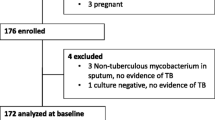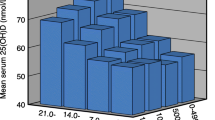Abstract
The prevalence of hypercalcemia in patients with untreated tuberculosis (TB) varies widely between countries. Since the vitamin D status and calcium intake are important determinants of hypercalcemia in TB, these two factors were compared among four populations (U.K., Hong Kong, Malaysia, Thailand) with a low prevalence (< 3%) and two populations (Sweden, Australia) with a high prevalence (> 25%). In the three Asian countries, the circulating vitamin D levels are abundant, but the calcium intakes are low. Subjects from the U.K. have the lowest circulating vitamin D level of all, although their calcium intake is high. In Sweden and Australia, both the circulating vitamin D levels and calcium intakes are high. Since serum 1,25(OH)2D concentration will only be raised if its substance for extrarenal conversion, 25(OH)D, is plentiful and the effect of a given serum 1,25 (OH)2D concentration on serum calcium is determined by the calcium intake, it is postulated that the regional variation in the prevalence of hypercalcemia in TB may be due to differences in the circulating vitamin D levels and calcium intakes in these populations.
Similar content being viewed by others
References
Cadranel J, Garabedian M, Milleron B, Guillozo H, Akoun GM, Hance A (1990) 1,25(OH)2D3 production by T lymphocytes and alveolar macrophages recovered from normocalcemic patients with tuberculosis. J Clin Invest 85:1588–1593
Chan TYK, Chan CHS (1994) Abnormal calcium and vitamin D metabolism in tuberculosis. Trop Geogr Med 46:280–282
Abbasi AA, Chemplavil JK, Farah S, Muller BF, Arnstein AF (1979) Hypercalcaemia in active pulmonary tuberculosis. Ann Intern Med 90:324–328
Sharma SC (1981) Serum calcium in pulmonary tuberculosis. Postgrad Med J 57:694–696
Kitrou MP, Phytou-Pallikari A, Tzannes SE, Virvidakis K, Mountokalakis TD (1982) Hypercalcaemia in active pulmonary tuberculosis. Ann Intern Med 96:255
Lind L, Ljunghall S (1990) Hypercalcaemia in pulmonary tuberculosis. Upsala J Med Sci 95:157–160
Need AG, Philips PJ, Chiu FTS, Prisk HM (1980) Hypercalcaemia associated with tuberculous. BMJ 1:831
Davies PDO, Brown RC, Woodhead JS (1985) Serum concentrations of vitamin D in untreated tuberculosis. Thorax 40:187–190
Davies PDO, Brown RC, Church HA, Woodhead JS (1987) The effect of anti-tuberculous chemotherapy on vitamin D and calcium metabolism. Tubercle 68:261–266
Chan TYK, Poon P, Pang J, Swaminathan R, Chan CHS, Nisan M, Williams CSD, Davies PDO (1994) A study of the calcium and vitamin D metabolism in Chinese patients with pulmonary tuberculosis. J Trop Med Hyg 97:26–30
Chan TYK, Chan CHS, Shek CC (1994) The prevalence of hypercalcaemia in pulmonary and miliary tuberculosis—a longitudinal study. Singapore Med J 35:613–615
Bandele EO, Afonja OA (1987) Plasma calcium in active pulmonary tuberculosis. J Natl Med Assoc 79:981–983
Davies PDO, Church HA, Bovornkitti S, Charumilind A, Byrachandra S (1988) Altered vitamin D homeostasis in tuberculosis. Intern Med (Thailand) 4:45–47
Tan TT, Lee BC, Khalid BAK (1993) Low incidence of hypercalcaemia in tuberculosis in Malaysia. J Trop Med Hyg 96:349–351
Payne RB, Little AJ, Williams RB, Miller JR (1973) Interpretation of serum calcium in patients with abnormal protein. BMJ 4:643–646
Pain RW, Rowland KM, Phillips PJ, Duncan BMcL (1975) Current “corrected” calcium concept challenged. BMJ 4: 617–619
McKenna MJ (1992) Differences in vitamin D status between countries in young adults and the elderly. Am J Med 93:69–77
Nordin BEC, Marshall DH (1988) Dietary requirements for calcium. In: Nordin BEC (ed) Calcium in human biology. Springer-Verlag, Berlin, p 447
Morris HA, Morrison GW, Burr M, Thomas DW, Nordin BEC (1984) Vitamin D and femoral neck fractures in elderly South Australian women. Med J Aust 140:519–521
Epstein S, Stern PH, Bell NH, Dowdeswell I, Turner RF (1984) Evidence for abnormal regulation of circulating 1α,25-dihydroxyvitamin D in patients with pulmonary tuberculosis and normal calcium metabolism. Calcif Tissue Int 36:541–544
Shai F, Baker RK, Addrizzo JR, Wallach S (1972) Hypercalcaemia in mycobacterial infection. J Clin Endocrinol Metab 34:251–256
Author information
Authors and Affiliations
Rights and permissions
About this article
Cite this article
Chan, T.Y.K. Differences in vitamin D status and calcium intake: Possible explanations for the regional variations in the prevalence of hypercalcemia in tuberculosis. Calcif Tissue Int 60, 91–93 (1997). https://doi.org/10.1007/s002239900192
Received:
Accepted:
Issue Date:
DOI: https://doi.org/10.1007/s002239900192




